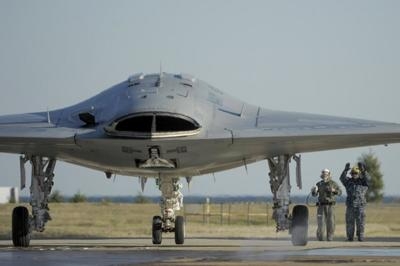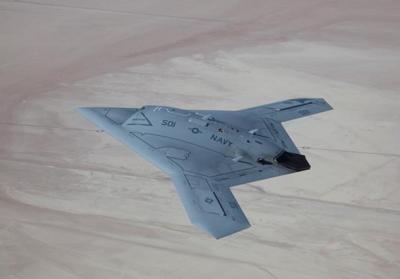Mon, Nov 19, 2012
Maneuvers With Handheld Controller Build Confidence For Future Trials On Carrier Deck
UAV carrier ops took another notch forward recently, as the U.S. Navy took the first critical step toward demonstrating that the X-47B Unmanned Combat Air System (UCAS) demonstrator can be maneuvered safely and wirelessly on the crowded deck of an aircraft carrier.

In early November, the team successfully completed its first shore-based trials of a new wireless, handheld device called a Control Display Unit (CDU). Developed by Northrop Grumman, the device will allow deck operators to maneuver the X-47B by remote control on the carrier deck. The team demonstrated the CDU's ability to control the X-47B's engine thrust; to roll the aircraft forward, brake and stop; to use its nose wheel steering to execute tight, precision turns; and to maneuver the aircraft efficiently into a catapult or out of the landing area following a mock carrier landing. Northrop Grumman is the Navy's prime contractor for the UCAS Carrier Demonstration (UCAS-D) program.
"The CDU is fundamental to integrating the X-47B seamlessly into carrier deck operations," said Daryl Martis, Northrop Grumman's UCAS-D test director. "It will allow us to move the aircraft quickly and precisely into the catapult for launch, or out of the landing area following recovery. Both of these activities are essential to maintaining the rhythm of the flight deck."
In practice, a deck operator will work in tandem with the flight deck director – aka a "yellow shirt" – to move the X-47B via the CDU to a designated flight deck location. Standing in front of the aircraft, the director will use traditional hand signals to indicate how, when and where the aircraft should move, the same way he would communicate with a pilot in a manned aircraft. The deck operator will stand behind the director and use the CDU to duplicate the director's instructions as digital commands to the aircraft. According to Martis, the CDU will help streamline and, in fact, enable many of the flight test operations required for UCAS-D shore-based carrier suitability testing. "Instead of towing the aircraft out to the flight line, we can now start the X-47B outside its hangar, then use the CDU to taxi it out to the runway, or into a catapult for launch," he said. "Use of the CDU is the most time-efficient way to move the X-47B into the catapult or disengage it from the arresting gear
after landing."
The UCAS-D program plans to conduct its first shore-based catapults of X-47B aircraft later this month. That testing will be followed by hoisting an X-47B aboard an aircraft carrier, and using it to validate the performance of the CDU in an actual carrier environment.
(U.S. Navy images)

More News
Also: Centauri Aircraft Valkyrie, Meet the Admin, Night Airshow, Pelton Intv'w When we laid eyes on this critter, we fell in love… and then we learned the amazing story of t>[...]
Check out Blackshape in Oshkosh Display #190 Situated in the Apulian Aerospace district in Monopoli, Italy, Blackshape embodies the epitome of Italian craftsmanship, style, and qua>[...]
A Powerhouse In Aviation Safety Technology, Visit Alpha Systems AOA at Osh Display#3124-3125 Alpha systems AOA has been developing and integrating Angle of Attack systems for the l>[...]
High-Flying Models By PilotMall.com: Honoring Aviation's Legacy We are dedicated to preserving and celebrating our rich aviation heritage through stunning mahogany wood scale repli>[...]
CiES Has Pioneered Life Saving Technology Of Use To Pilots All Over The World... Booth 3119 CiES: CiES Inc. is the global leader in digital fuel quantity sensors for general aviati>[...]
 OSH25 Day Four Redux: Spirit SE-1!, H55 eFlyer, King Schools
OSH25 Day Four Redux: Spirit SE-1!, H55 eFlyer, King Schools ANN Thanks Our Speedy Sponsor... Blackshape!!!
ANN Thanks Our Speedy Sponsor... Blackshape!!! Alpha Systems AOA Guides ANN Oshkosh Coverage
Alpha Systems AOA Guides ANN Oshkosh Coverage Pilot Mall Intro's High Flying Models To ANN Sponsor Lineup
Pilot Mall Intro's High Flying Models To ANN Sponsor Lineup CiES Fuels ANN's Oshkosh 2025 Special Event Coverage
CiES Fuels ANN's Oshkosh 2025 Special Event Coverage




